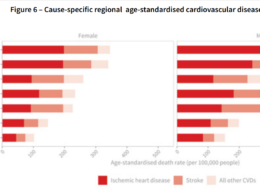the
health transformation
foundation
Joaquim Cardoso Msc
30 de Janeiro de 2024
Key takeaways:
Record-breaking new cancer cases: The U.S. is expected to see over 2 million new cancer cases in 2024, along with over 611,000 cancer deaths.
Leading causes of cancer death: Lung, colorectal, and pancreatic cancers are identified as the primary causes of cancer death.
Rise in common cancers: Breast, prostate, kidney, and other common cancers are increasing in incidence among the general population, with colorectal and cervical cancers on the rise in younger people.
Decline in cancer mortality: Despite the rise in new cases, cancer mortality has been steadily declining over the past 30 years, attributed to advancements in treatment, early detection, and reduced smoking rates.
Factors contributing to rising incidence: Factors such as population growth, aging, and increased obesity are contributing to the rise in cancer incidence.
Disparities in cancer impact: Racial disparities persist in both cancer incidence and mortality, with Black Americans facing higher mortality rates and less access to quality care compared to white Americans.
Importance of prevention and screening: Behavioral modifications, such as maintaining a healthy lifestyle, quitting smoking, and undergoing regular screenings for cancers like cervical, colorectal, and lung cancer, can help prevent and detect cancer early.
Need for increased screening: Despite available screening tools, such as lung cancer screening guidelines, a low percentage of eligible individuals undergo screening, highlighting the importance of raising awareness and encouraging utilization of screening services.
Empowerment through knowledge: Understanding family history and discussing screening options with healthcare providers can empower individuals to take proactive steps in cancer prevention and early detection.
Key Statistics
- Estimated new cancer cases in the U.S. for 2024: Over 2 million.
- Estimated cancer deaths in the U.S. for 2024: Over 611,000.
- Daily deaths from lung cancer: 340.
- Percentage of cancers potentially preventable through behavioral modifications: Approximately 40%.
- Percentage of eligible patients undergoing lung cancer screening in 2020: Just 6%.
- Increase in early-onset cancer rate between 2010 and 2019: 0.74%.
- Decline in cancer mortality over the past 30 years: Resulting in more than 4 million deaths from cancer averted since the early 1990s.
- Racial disparities in cancer mortality: Black Americans face elevated cancer mortality risk and disparities in outcomes for colorectal, breast, prostate, and lung cancers.
- Common cancers on the rise: Breast, prostate, kidney, and other common cancers are increasing in incidence among the general population, with colorectal and cervical cancers on the rise in younger people.
- Leading causes of cancer death: Lung, colorectal, and pancreatic cancers.
- Factors contributing to rising cancer incidence: Population growth, aging, and increased obesity.


Key Conclusions and Recommendations:
Cancer incidence is rising: The article highlights a significant increase in new cancer cases in the U.S., with breast, prostate, kidney, and other common cancers on the rise among the general population, and colorectal and cervical cancers increasing in younger individuals.
Decline in cancer mortality: While new cases are increasing, there has been a steady decline in cancer mortality over the past 30 years, attributed to advancements in treatment, early detection, and reduced smoking rates.
Racial disparities persist: The article underscores significant racial disparities in cancer incidence and mortality, with Black Americans facing higher mortality rates and less access to quality care compared to white Americans.
Prevention and screening are crucial: Behavioral modifications such as maintaining a healthy lifestyle, quitting smoking, limiting alcohol intake, and undergoing regular screenings for cervical, colorectal, and lung cancers are recommended to prevent and detect cancer early.
Low utilization of screening services: Despite available screening tools, a low percentage of eligible individuals undergo screening, indicating a need for increased awareness and utilization of screening services.
Empowerment through knowledge: Understanding family history and discussing screening options with healthcare providers can empower individuals to take proactive steps in cancer prevention and early detection.
Need for further research: The article suggests that the data presented could serve as a jumping-off point for future research, including investigating the impact of the COVID-19 pandemic on cancer rates and addressing why younger people are experiencing cancer more frequently.

DEEP DIVE
Health
By Julia Landwehr
Fact checked by Nick Blackmer
The U.S. is estimated to see a record-breaking amount of new cancer cases in 2024, according to a report from the American Cancer Society (ACS).
The new data, published earlier this month in CA: A Cancer Journal for Clinicians, tracked general trends in cancer incidence (new cases) and cancer mortality (deaths from cancer).
Based on that new data, the ACS estimates that the U.S. will see just over 2 million new cancer cases in 2024, as well as over 611,000 cancer deaths.
The report found that lung, colorectal, and pancreatic cancers are the leading causes of cancer death.
In the general population, breast, pancreas, prostate, kidney, and other common cancers are on the rise. In younger people, researchers note an increase in incidences of colorectal and cervical cancers.
While the statistics in the report are in line with what experts expect to see, the figures are still quite considerable, said Jacob Stein, MD, MPH, assistant professor in the Division of Oncology at the University of North Carolina School of Medicine.
“
I would say, it’s a pretty huge number-it reflects what a substantial burden cancer has in our country,” he told Health.
Cancer Deaths on the Decline, New Cases on the Rise
The data the report used was gathered from the Centers for Disease Control and Prevention (CDC), the National Cancer Institute, and other registries. That data for cancer incidences goes up to 2020; the data for mortality goes up to 2021.
According to Stein, the report helps “to highlight for physicians, policymakers, [and] healthcare organizations where to focus efforts in the year to come.”
In terms of cancer mortality, the overall data on cancer deaths is holding steady-a good sign.
“
We were very happy to see a continuation of the decline in cancer mortality, which has dropped now for the past 30 years,” Rebecca Siegel, MPH, report co-author and senior scientific director of surveillance research at the American Cancer Society, told Health.
“
That equates to more than 4 million deaths from cancer averted [since the early 1990s],” Siegel said.
She explained that progress is because of improvements in cancer treatments, and a general trend of detecting cancers at earlier stages. Additionally, smoking has lessened in popularity.
Data outlining cancer incidence is a bit more alarming-it’s relatively similar to years past, but notably, this is the first time the country has reached the benchmark of 2 million new estimated cancer cases, Siegel said.
“
There are [an] increasing number of cases being diagnosed in six of the top 10 cancer types, including 2–3% increases for prostate, kidney, and certain oral cancers,” Laura Huppert, MD, assistant professor of medicine and breast oncologist in the Division of Hematology and Oncology at the UCSF Helen Diller Family Comprehensive Cancer Center, told Health.
Between 2015 and 2019, the U.S. also saw small increases in new breast, pancreatic, and uterine corpus (endometrial) cancer cases.
There are several reasons that experts believe cancer incidence is on the rise. Siegel explained that, in some cases, it may be that more cancers are developing in the population, which is growing and aging more each year.
It’s also true that certain cancers are becoming more prevalent due to an increase in risk factors like obesity, which is related to an increased risk of 13 different cancers, she said.
For other cancers, however, it’s “a little harder to say whether there are ‘true’ increases in incidence,” Stein clarified.
Some cancers could look like they’re increasing in incidence when the reality is that doctors are simply more accurately diagnosing cases.
Prostate cancer is a good example of this, Stein explained-what appears to be a spike in prostate cancer cases in the 1990s and 2000s was simply an increase in more widespread prostate-specific antigen (PSA) testing.
Cancers Don’t Affect Everyone Equally
In addition to general information on cancer incidence and mortality, the ACS report outlined specific groups most impacted by current cancer trends.
For people under 50, colorectal cancer is now the leading cause of cancer death for men and the second leading cause of cancer death for women. This was not the case even a few decades ago.
“
In people younger than 50, there’s been a steep decline in deaths from lung cancer, and then [an] increasing number of deaths from colorectal cancer,” said Siegel. “Those two patterns combined have produced this pretty rapid shift.”
Other reports and studies support the idea that cancer is rising among younger generations-a study published in August found that the rate of early-onset cancer rose by 0.74% between 2010 and 2019.
In addition to the age at which people may be getting cancer, the new ACS report highlighted stark racial disparities when it comes to both cancer incidence and mortality.
“
As much as people are now talking about [health disparities] and working on making progress, I think this shows that we still have a long way to go,” said Stein. “There were racial disparities in mortality for basically every single cancer type.”
Another report, published earlier this month in JAMA Open Network, found that Black Americans’ general elevated cancer mortality risk decreased slightly between 2000 and 2020, but significant disparities still existed in outcomes for colorectal, breast, prostate, and lung cancers in particular.
Compared to white Americans, Black Americans tend to be diagnosed with more aggressive cancers, have higher mortality rates, and have less access to quality care, Siegel explained.
“
Honestly, there are gaps at every point in the cancer continuum, that’s what contributes to these wide, distinct disparities,” she said.
What the ACS Report Tells Us About the Future of Cancer
According to Stein, the data outlined in the yearly ACS report is oftentimes a jumping-off point for future research.
It may inspire further research into questions raised by the ACS, including how the COVID pandemic may have affected cancer rates, why younger people are getting cancer more frequently, and what tools can effectively close gaps in cancer mortality for Americans of color.
These statistics are also a good reminder to do what they can to avoid cancer. For one, that means adopting lifestyles associated with a lower risk of cancer.
“
We estimate that about 40% of all cancers that are diagnosed are potentially preventable through behavioral modifications,” said Siegel.
That means, whenever possible, people should do their best to maintain a healthy weight, stay active, quit smoking, limit alcohol intake, and eat a diet high in fruits and vegetables and low in red or processed meats, she said.
More importantly, the rise in cancer incidence should prompt people to get screened for different cancers.
Many of the cancers causing concern in this report-namely cervical, colorectal, and lung cancer-are all screenable, explained Stein. He recommended that people utilize pap smears, colonoscopies, HPV vaccines, computed tomography (CTs), and other available tools so these cancers can be caught early.
For instance: 340 people die from lung cancer daily. To address this issue, the American Cancer Society has broadened its annual lung cancer screening guidelines, but most people still aren’t taking advantage.
“
Relatively few patients have been undergoing this screening-they estimate just 6% of eligible patients in 2020,” Huppert said. “It is important for individuals who have a history of smoking and [who] are eligible for this screening to discuss it with their doctors.”
Ultimately, preventative action is key.
“
[It’s] just really understanding what your family history is, and then acting on it by talking to your doctor about when it’s right for you to start screening,” Siegel said.
Sources:
- Siegel RL, Giaquinto AN, Jemal A. Cancer statistics, 2024. CA Cancer J Clin. 2024;74(1):12–49. doi:10.3322/caac.21820
- Koh B, Tan DJH, Ng CH, et al. Patterns in cancer incidence among people younger than 50 years in the US, 2010 to 2019. JAMA Netw Open. 2023;6(8):e2328171. doi:10.1001/jamanetworkopen.2023.28171
- Gupta A, Akinyemiju T. Trends in cancer mortality disparities between Black and White individuals in the US, 2000–2020. JAMA Health Forum. 2024;5(1):e234617. doi:10.1001/jamahealthforum.2023.4617
Originally published at https://www.health.com.
Names mentioned
- Jacob Stein, MD, MPH: Assistant Professor in the Division of Oncology at the University of North Carolina School of Medicine.
- Rebecca Siegel, MPH: Report co-author and Senior Scientific Director of Surveillance Research at the American Cancer Society.
- Laura Huppert, MD: Assistant Professor of Medicine and Breast Oncologist in the Division of Hematology and Oncology at the UCSF Helen Diller Family Comprehensive Cancer Center.

Cancerstatistics,2024
Rebecca L. SiegelMPH, Angela N. GiaquintoMSPH1, Ahmedin JemalDVM,PhD
Abstract
Each year, the American Cancer Society estimates the numbers of new cancer cases and deaths in the United States and compiles the most recent data on population‐ based cancer occurrence and outcomes using incidence data collected by central cancer registries (through 2020) and mortality data collected by the National Center for Health Statistics (through 2021).
In 2024, 2,001,140 new cancer cases and 611,720 cancer deaths are projected to occur in the United States.
Cancer mortality continued to decline through 2021, averting over 4 million deaths since 1991 because of reductions in smoking, earlier detection for some cancers, and improved treatment options in both the adjuvant and metastatic settings.
However, these gains are threatened by increasing incidence for 6 of the top 10 cancers. Incidence rates increased during 2015–2019 by 0.6%–1% annually for breast, pancreas, and uterine corpus cancers and by 2%–3% annually for prostate, liver (female), kidney, and human papillomavirus‐associated oral cancers and for melanoma. Incidence rates also increased by 1%–2% annually for cervical (ages 30–44 years) and colorectal cancers (ages <55 years) in young adults. Colorectal cancer was the fourth‐leading cause of cancer death in both men and women younger than 50 years in the late‐1990s but is now first in men and second in women.
Progress is also hampered by wide persistent cancer disparities; compared to White people, mortality rates are two‐fold higher for prostate, stomach and uterine corpus cancers in Black people and for liver, stomach, and kidney cancers in Native American people.
Continued national progress will require increased investment in cancer prevention and access to equitable treatment, especially among American Indian and Alaska Native and Black individuals
Originally published at https://www.health.com.











